
Peter Forsskål, sometimes spelled Pehr Forsskål, Peter Forskaol, Petrus Forskål or Pehr Forsskåhl was a Swedish-speaking Finnish explorer, orientalist, naturalist, and an apostle of Carl Linnaeus.
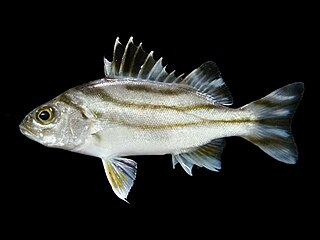
Terapon jarbua, the jarbua terapon, crescent grunter, crescent banded grunter, crescent perch, spiky trumpeter, thornfish or tiger perch, is a species of ray-finned fish, a grunter of the family Terapontidae. It occurs in the Indo-Pacific. it is an important commercial species within its range and is sometimes found in the aquarium trade where it is known as "target fish" for the pattern visible from above.

Eriphia verrucosa, sometimes called the warty crab or yellow crab, is a species of crab found in the Black Sea, Mediterranean Sea and eastern Atlantic Ocean from Brittany to Mauritania and the Azores. Individual crabs have been caught as far north as Cornwall. Formerly a frequent species in the Black Sea, it has decreased in numbers since the 1980s and is now listed in the Ukrainian Red Data Book of endangered species.
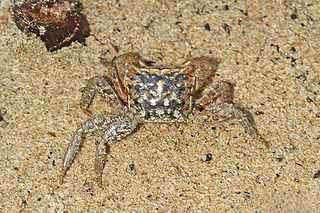
Metopograpsus messor is a species of grapsid crab that lives in mangroves from East Africa to Fiji.

Xantho hydrophilus, the furrowed crab or Montagu's crab, is a species of crab from the family Xanthidae. It is yellowish-brown and grows to a carapace width of 70 mm (2.8 in). It is a nocturnal omnivore that lives in shallow marine waters from western Scotland to the Cape Verde Islands.

Coenobita scaevola is a species of terrestrial hermit crab from the western Indian Ocean and Red Sea.
Brachynotus sexdentatus is a species of crab in the family Varunidae. It is native to the Mediterranean Sea and Black Sea, and became established for a time in Swansea Docks. It grows to a maximum carapace width of 18 mm (0.71 in), and lives in shallow water on muddy bottoms.
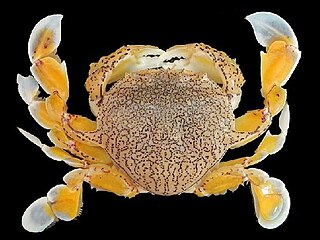
Matuta planipes is a species of moon crab in the family Matutidae. It is a small colorful crab with flattened limbs. The Matuta planipes, in contrast to other species of crabs inhale pure oxygen-water through an area near their eye sockets. This species of crabs enjoy spending their daytime hidden under some sort of shade such as a sand bed and they are more active during the night. This species of crab comes from the tropical waters of the Indo-Pacific and Australia. Additionally, they have a widespread distribution that extends from the Red Sea to South Africa, Asia, and Australia.
Atergatis roseus, the rosy egg crab, is a species of reef crab from the family Xanthidae with a natural range extending from the Red Sea to Fiji. It has colonised the eastern Mediterranean by Lessepsian migration through the Suez Canal. The flesh of this crab, like many other species in the family Xanthidae, is toxic.
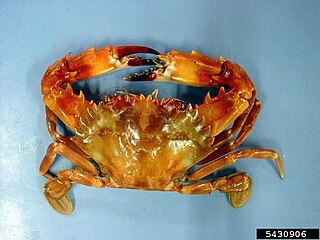
Charybdis hellerii, the Indo-Pacific swimming crab or spiny hands is a species of crab from the swimming crab family, the Portunidae. Its native range covers the Indian and Pacific Oceans but it has been introduced to the western Atlantic and has invaded the Mediterranean. It is a commercially exploited species in south-east Asia.

Crenidens crenidens, the karanteen seabream or karanteen, is a species of ray-finned fish from the sea bream family Sparidae which was described by the Swedish zoologist Peter Forsskål in 1775. It is native to the western Indian Ocean but has colonised the eastern Mediterranean Sea since 1970. It is one of only three species in genus Crenidens, the others being the little known Crenidens macracanthus and the partially sympatric C. indicus.

Hemiramphus far, the halfbeak, black-barred halfbeak, black-barred garfish, barred halfbeak, barred garfish or spotted halfbeak, is a schooling marine fish in the family Hemiramphidae. It has an Indo-Pacific distribution and has invaded the eastern Mediterranean through the Suez Canal.

Eucrate crenata, the blunt-spined euryplacid crab, is a species of Indo-Pacific crab from the family Euryplacidae. It has invaded the Mediterranean Sea from the Red Sea by Lessepsian migration through the Suez Canal.

Actea savignii is a species of Indo-Pacific crab from the family Xanthidae which is one of the spiny-legged rock crabs. It has colonised the Levantine Sea by Lessepsian migration through the Suez Canal from the Red Sea since the mid 2000s.

Hyastenus hilgendorfi is a species of spider crab from the family Epialtidae, classified in the sub-family Pisinae, from the Indo-Pacific region. It has been recorded in the Suez Canal and there have been a few records in the eastern Mediterranean, making it a Lessepsian migrant.
Notopus dorsipes is a species of frog crab from the family Raninidae which has an Indo-Pacific distribution and which has recently spread into the eastern Mediterranean. It is the only extant species in the genus Notopus.
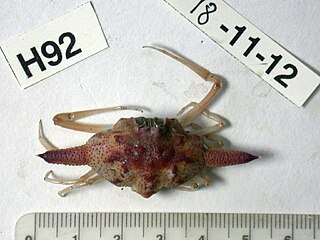
Ixa monodi, the Red Sea pebble crab is a species of pebble crab from the family Leucosiidae which prefers to burrow in sandy, shallow coastal waters. It was first described from the eastern Mediterranean where it is an invasive species having colonised the coasts of the Levantine Sea from the Red Sea by Lessepsian migration from the Red Sea via the Suez Canal.
Charybdis longicollis, the lesser swimming crab, is a species of crab from the swimming crab family, the Portunidae. It has a native range which covers the north-western Indian Ocean and it has invaded the Mediterranean Sea by Lessepsian migration through the Suez Canal.
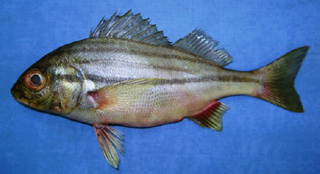
Pomadasys stridens, the striped piggy or lined piggy, is a grunt from the western Indian Ocean, it is one of a group of Indo-Pacific marine species which have colonised the Mediterranean Sea through the Suez Canal from the Red Sea, a process known as Lessepsian migration.

Portunus segnis, the African blue swimming crab, is a species of crustacean, a swimming crab belonging to the family Portunidae. While native to the western Indian Ocean, it is also invasive in the Mediterranean. It is thought to have come through the Suez Canal from the Red Sea but it may have been transported by ships.


















